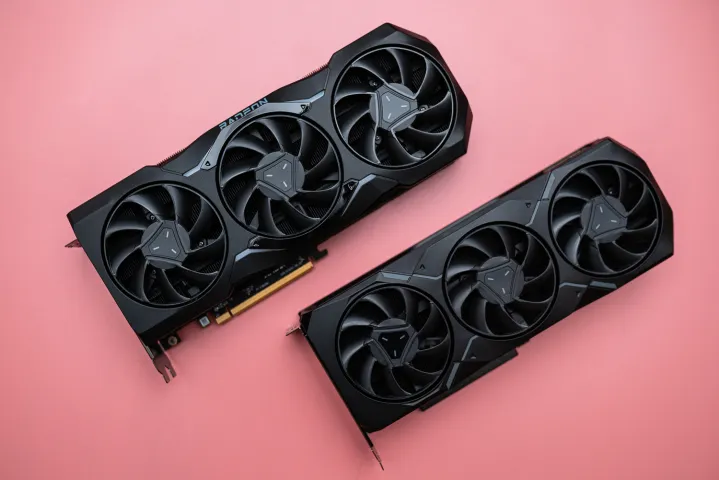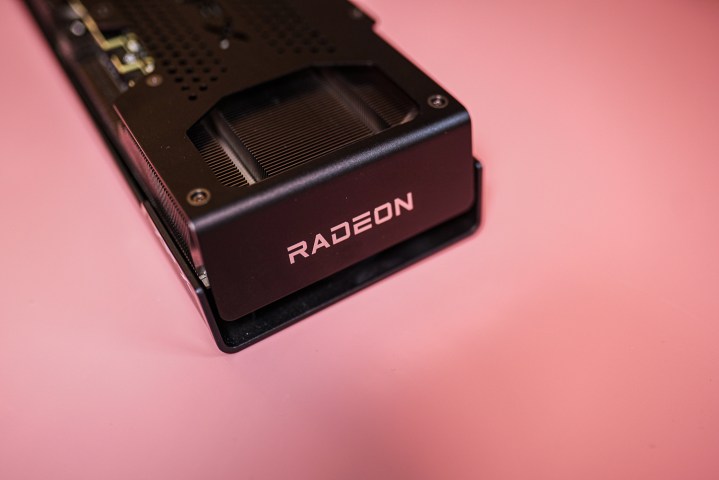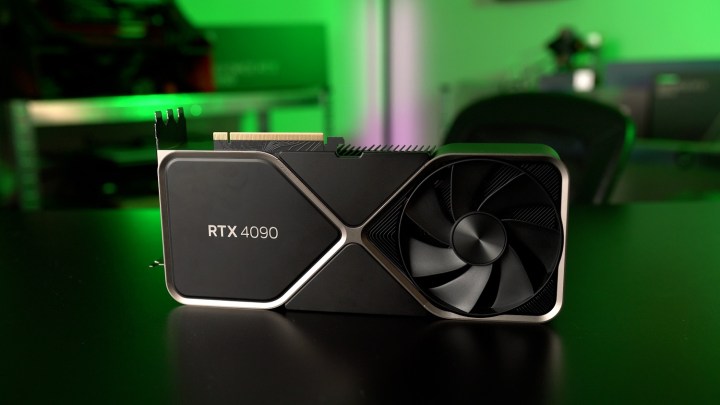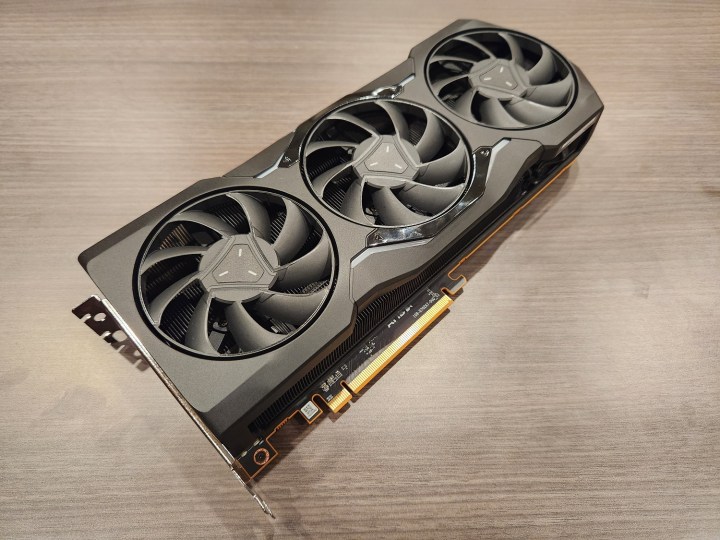Both Nvidia and AMD are expected to launch new graphics cards within the next few months. It’s no secret as to which of the two lineups has a higher chance of topping the charts with one of the best GPUs.
AMD is said to be sitting out of the high-end race this generation, and although this could be the right approach for AMD, it’s actually really bad news for Nvidia fans. As a gamer, letting Nvidia monopolize the consumer GPU sphere is the last thing that I wish for.
A not-so-heated rivalry
 Jacob Roach / Digital Trends
Jacob Roach / Digital TrendsThe signs of a healthy GPU market include plenty of stock, no shortages, reasonable prices, and some degree of rivalry between the two — well, three, if you count Intel — competitors.
Get your weekly teardown of the tech behind PC gaming
Unfortunately, I have to say that the GPU market is definitely at risk of slipping into “unhealthy” territory, and that’s not because of any chip shortages. It’s more that the rivalry between AMD and Nvidia has cooled down, and things are unlikely to get any better going forward.
Some of it may be just that we haven’t had any new GPU releases for a while, and it was Nvidia that came out with three new graphics cards at the beginning of the year. The RTX 40 Super refresh was a hit all around, with a cheaper RTX 4080 Super and two solid options in the form of the RTX 4070 Ti Super and the RTX 4070 Super.
Meanwhile, AMD’s had two GPUs come out this year. One of them, the RX 7600 XT, barely moved the needle when compared to its non-XT counterpart; the XT card is only around 6% faster, but even months after the release, it still costs around $50 to $60 more. These numbers just don’t add up. There’s also the RX 7900 GRE, which was a mighty show of balance between cost and performance — let’s have more of that in RDNA 4, please.
With a quietish GPU market, it’s no wonder that things are starting to feel a bit stale. What’s more, even though both manufacturers were initially said to launch next-gen GPUs this year, it’s highly unlikely to happen at this point.
 Jacob Roach / Digital Trends
Jacob Roach / Digital TrendsEven still, although both Nvidia and AMD haven’t released any next-gen GPUs this year, it’s Nvidia that’s slowly chipping away at AMD’s market share. The latest data shows that in the second quarter of 2023, AMD held a 17% add-in board (AIB, or discrete GPU) market share. A year later, in the second quarter of 2024, it’s down to 12%. Intel’s had it rough, too. It had a measly 2% graphics card market share one year ago, but now, it’s down to 0%.
There’s more. Earlier this year, AMD revealed that its overall gaming revenue in the first quarter of 2024 was down by 48% year-over-year. AMD only expected things to get worse in the second half of 2024.
This leaves Nvidia sitting pretty with 88% of the GPU market in its hands.
A sound, but disappointing decision
 Jacob Roach / Digital Trends
Jacob Roach / Digital TrendsFor many months now, various leakers have all been in agreement when it comes to one thing: Creating a high-end RDNA 4 graphics card is not a priority for AMD, and it’s not going to happen. If there ever was such a GPU (and many have said that it existed), it’s been canceled.
The current expectation is that AMD’s flagship will be close to the RX 7900 XT in rasterization, but it’ll surpass it in ray tracing. That’s not much of an improvement, and this type of performance will probably make the flagship RX 8000 series card a rival for Nvidia’s RTX 5070 Ti at best. Mind you, I’m merely speculating based on leaks — AMD hasn’t disclosed its plans for RDNA 4 just yet. It could still surprise us all.
It’s not just that AMD isn’t aiming high with its next-gen cards, but also that it might be falling behind in adopting the latest memory tech. While Nvidia is said to switch to GDDR7 memory in the RTX 50-series — perhaps including the latest 24Gb modules — AMD is said to be sticking to GDDR6. AMD never adopted GDDR6X in the first place, which Nvidia has been using in this whole current gen of cards, and AMD might still not make the switch in RDNA 4.
On the other hand, AMD does have the upper hand in a couple of ways. Its GPUs generally have higher memory capacity than their Nvidia equivalents, and Infinity Cache helps offset the lower bandwidth. AMD has also already adopted the DisplayPort 2.1 connector, which Nvidia will only include in the RTX 50-series. But still, if Nvidia uses GDDR7 memory across its entire lineup, there’s bound to be a large difference in bandwidth between comparable cards.
All of the above leaks point to a mainstream card. Nvidia may remain unmatched at the high end, and in all likelihood, the best we can hope to see is an AMD flagship that can beat the RTX 4080 Super.
 Jacob Roach / Digital Trends
Jacob Roach / Digital TrendsI’m no market analyst, but even I know that this is most likely a sound decision. As I’ve said before, there’s a lot of merit in aiming for the mainstream market. After all, most of us won’t be buying the likes of the RTX 5090. There’s a reason why Nvidia’s xx60 cards top the Steam Hardware Survey month after month: Mainstream GPUs are more affordable and sufficient for the vast majority of gamers. And if AMD knows that it can’t beat the RTX 5090, it makes sense for it to stick to familiar waters and target the market that’s more open to its graphics cards.
Smart as it may be, this decision is worrying, and I don’t just mean for AMD enthusiasts. In fact, Nvidia fans might suffer from this lack of competition more than those who buy AMD GPUs.
A $2,500 GPU?
 Jacob Roach / Digital Trends
Jacob Roach / Digital TrendsRecently, we’ve talked about a worrying leak that reportedly comes from one of Nvidia’s partners. It had to do with the possible pricing for the RTX 50-series, and I’m not going to lie: It was decidedly not good news. Moore’s Law Is Dead cited an anonymous source when reporting that Nvidia might charge between $2,000 and $2,500 for an RTX 5090. This would be followed by a $1,200 to $1,500 RTX 5080, and a $600 to $700 RTX 5070.
This is what I mean by “letting Nvidia run rampant.” With no competition from AMD, Nvidia has less of an incentive to try to keep its prices reasonable, and this could result in this kind of crazy pricing across the entire stack.
What’s worse is that these kinds of inflated prices would affect not just those who want to buy an RTX 5090. A $1,200 to $1,500 RTX 5080 is pretty outrageous, especially if you consider that Nvidia actually lowered the pricing of the RTX 4080 from $1,200 to $1,000 when it rereleased it as a slightly tweaked Super version. And $700 for an RTX 5070? That’s $100 more than the RTX 4070 at launch; not to mention that these days, you’ll find it for as low as $530.
Fortunately, I have to say that a $2,500 RTX 5090 seems pretty much impossible. (Let’s hope I don’t eat my words in a few months time.) That’s the same price as the RTX Titan, and nobody loved how expensive that card was. Even the RTX 3090 Ti, which was outrageously pricey, was “only” $2,000. The RTX 5090 may be a step up, but that kind of pricing should still be reserved for something even more powerful; perhaps the RTX 5090 Ti, if that ever happens.
I don’t think that a $2,500 RTX 5090 will become a reality. But there’d be even less of a chance of it happening if AMD was there, with a card fit to compete against at least the 5080 at a much more reasonable price point. I’m talking something like what the RX 7900 XTX could’ve been if AMD priced it lower from the get-go.
As things stand now, Nvidia is raking in all the market recognition, too. The number of RTX 50-series leaks is growing by the day, but there’s not been much about RDNA 4. Perhaps AMD is keeping information closer to the vest, but that doesn’t help in building anticipation for a generation that might feel underwhelming in a world where everyone is hyperfocused on performance gains.
Too early to panic
 Jacob Roach / Digital Trends
Jacob Roach / Digital TrendsAlthough I wish AMD had more of a presence in the GPU market, it’s definitely not yet the time to panic.
We’ve seen AMD claw its way up from near obscurity in the CPU market. Now, it’s a formidable competitor to Intel, with its X3D processors being widely touted as the gaming CPUs to buy. In fact, both the 5800X3D and the 7800X3D are pretty much sold out right now, and everyone’s holding their breath in anticipation of the upcoming 9800X3D. Intel’s Arrow Lake may struggle to generate that kind of hype.
AMD has done it before, and it can do it again if it wants to. It may never become a market leader in the GPU sphere, but it gives gamers an important alternative with solid GPUs that often tend to offer better performance per dollar than Nvidia’s.
Nvidia’s RTX 50-series pricing could get pretty crazy — that’s unfortunately true. However, most sources agree that $2,500 for the RTX 5090 is highly unlikely to happen. But $2,000? Yeah, I could see that happening. That’s still a lot, and it’s bound to push the prices of the rest of the lineup higher than they should be, too. I wish AMD could help prevent that from happening.
The truth is, Nvidia can push the prices higher if it wants to. Despite being expensive, the RTX 4090 stayed above the $1,600 recommended list price (MSRP) ever since it launched. If anything, the price has only gone up. With a consistent demand and people willing to pay above market price, I have a hard time holding out hope that Nvidia might keep its flagship around that $1,600 ballpark. I’ve resigned myself to that $1,800 to $2,000 figure, although I hope I’m wrong.
Pressure from AMD certainly would’ve helped. To stay healthy, the GPU market needs more than just Nvidia. I’m worried that we’ll see the full impact of Nvidia’s monopoly on the high-end graphics card market in the upcoming RTX 50-series. We’ll likely find out more during CES 2025 in January.











![iOS Decoded: iOS 18.3 RC new hidden features, changes and updates [Videos]](https://i0.wp.com/9to5mac.com/wp-content/uploads/sites/6/2025/01/iOS-18.3-Release-Candidate.jpg?resize=1200%2C628&quality=82&strip=all&ssl=1)









 English (US) ·
English (US) ·